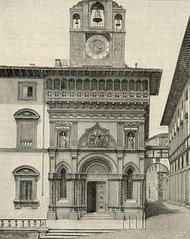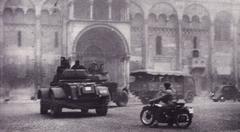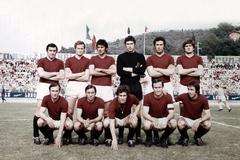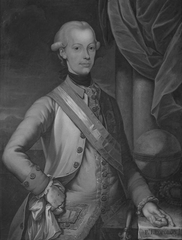Visiting Basilica di San Francesco: History, Tickets, and Tips
Date: 18/07/2024
Introduction
Nestled in the heart of Arezzo, Italy, the Basilica di San Francesco is an unassuming yet profoundly significant monument that draws art lovers, historians, and pilgrims alike. This Gothic-style basilica, built in the late 13th century, stands as a testament to the enduring legacy of the Franciscan order and the artistic genius of Piero della Francesca. While its exterior may appear modest, the basilica’s interior houses one of the most important fresco cycles of the early Renaissance—the Legend of the True Cross. This masterpiece, commissioned by the Bacci family, not only showcases the innovative use of perspective and light by Piero della Francesca but also narrates a story deeply rooted in Christian tradition. The basilica’s history, architectural features, and artistic treasures make it a must-visit destination for anyone exploring the rich cultural tapestry of Arezzo (Explore the Basilica di San Francesco).
Table of Contents
- Introduction
- From Humble Beginnings to Franciscan Haven
- The Patronage of the Bacci Family and a Legacy in Frescoes
- Piero della Francesca - Master of Perspective and Light
- The Legend of the True Cross - A Story in Pictures
- Beyond the Masterpiece - Architectural and Artistic Treasures
- Practical Information for Visitors
- Nearby Attractions
- A Place of Worship and Pilgrimage
- Frequently Asked Questions (FAQ)
- Conclusion
From Humble Beginnings to Franciscan Haven
The Basilica di San Francesco, dedicated to St. Francis of Assisi, stands on the site of a pre-existing church dating back to at least the 9th century. This early structure, likely modest in size and decoration, served a small community of Benedictine monks.
The arrival of the Franciscan order in Arezzo during the 13th century marked a turning point for the site. The Franciscans, known for their emphasis on poverty and humility, chose this location, then on the outskirts of the city, to establish their presence. Construction of the Gothic-style church we see today began around 1290, reflecting the architectural trends of the era.
The Patronage of the Bacci Family and a Legacy in Frescoes
The Basilica di San Francesco, like many religious structures of its time, benefited greatly from the patronage of wealthy families. The Bacci family, prominent wool merchants in Arezzo, played a pivotal role in shaping the basilica’s artistic heritage. They commissioned the renowned artist Bicci di Lorenzo to decorate the chapel with frescoes in the early 15th century. While only fragments of Bicci di Lorenzo’s work remain today, they offer a glimpse into the artistic trends preceding Piero della Francesca’s masterpiece.
The main chapel, however, would become synonymous with Piero della Francesca and his awe-inspiring fresco cycle. Commissioned by the Bacci family in the mid-15th century, the Legend of the True Cross narrates the story of the cross used in the crucifixion of Jesus, from its origins to its eventual rediscovery.
Piero della Francesca - Master of Perspective and Light
Piero della Francesca, a master of perspective and light, completed the fresco cycle over several years, likely between 1452 and 1466. The frescoes, arranged across three levels on the chapel walls, showcase his innovative use of linear perspective, creating a sense of depth and realism that was groundbreaking for its time.
The cycle unfolds chronologically, beginning with the Death of Adam and culminating in the Victory of Constantine and the Finding of the True Cross. Each scene is meticulously composed, with life-sized figures inhabiting realistically rendered landscapes and architectural settings. The frescoes are renowned for their vibrant colors, dramatic use of light and shadow (chiaroscuro), and the emotional depth conveyed through the figures’ expressions and gestures.
The Legend of the True Cross - A Story in Pictures
The Legend of the True Cross fresco cycle is not merely a work of art; it’s a visual narrative deeply rooted in Christian tradition. The story, popularized in Jacobus de Voragine’s 13th-century text Golden Legend, follows the journey of the wood from the Tree of Knowledge of Good and Evil, used to create the cross, to its eventual rediscovery by Saint Helena, mother of Emperor Constantine I.
The cycle’s scenes, rich in symbolism and allegory, were intended to inspire devotion and contemplation among the faithful. They served as a visual reminder of Christ’s sacrifice and the triumph of good over evil.
Beyond the Masterpiece - Architectural and Artistic Treasures
While the Legend of the True Cross is undoubtedly the basilica’s most celebrated feature, the building itself and its other artistic treasures deserve attention. The basilica’s Gothic architecture, characterized by pointed arches and ribbed vaults, reflects the architectural trends prevalent during its construction. The simplicity of the façade, built with local sandstone, contrasts with the richly decorated interior.
Inside the basilica, visitors can admire several other notable artworks, including:
- The stained-glass window in the apse: Created in the 16th century by Guillaume de Marcillat, a French artist active in Arezzo, the window depicts the Coronation of the Virgin.
- The Chapel of St. Anthony of Padua: Located to the left of the main altar, this chapel houses a fresco cycle attributed to Spinello Aretino, a prominent late 14th-century painter from Arezzo.
- The Crucifixion by Margaritone d’Arezzo: This 13th-century painted crucifix, attributed to the local artist Margaritone d’Arezzo, is an important example of the Italo-Byzantine style.
Practical Information for Visitors
Visiting Hours
The Basilica di San Francesco is open to visitors daily. Typical visiting hours are from 9:00 AM to 6:00 PM, but it is advisable to check the official website for any changes or special closures.
Tickets
Admission to the basilica and access to view the Legend of the True Cross fresco cycle requires a ticket. Prices vary, with discounts available for students, seniors, and groups. Tickets can be purchased online or at the basilica’s ticket office.
Guided Tours
The basilica offers guided tours that provide deeper insights into its history and artworks. These tours can be booked in advance and are available in multiple languages.
Accessibility
The basilica is equipped to accommodate visitors with mobility issues, with ramps and designated viewing areas.
Nearby Attractions
Arezzo is rich in historical sites and cultural attractions. Visitors to the Basilica di San Francesco can also explore:
- Piazza Grande: The main square of Arezzo, known for its medieval architecture and the annual Joust of the Saracen festival.
- Cathedral of Arezzo: A stunning Gothic cathedral with beautiful stained glass windows and frescoes.
- Casa Vasari: The former home of Giorgio Vasari, now a museum showcasing his works and the history of Arezzo.
A Place of Worship and Pilgrimage
Throughout its history, the Basilica di San Francesco has served as a vital center for religious life in Arezzo. The Franciscan friars, who have maintained a continuous presence at the basilica since the 13th century, continue to hold regular services, welcoming both locals and visitors.
The basilica’s significance extends beyond its religious function. The presence of Piero della Francesca’s masterpiece has transformed it into a site of pilgrimage for art lovers worldwide. Today, the Basilica di San Francesco stands as a testament to the enduring power of art, faith, and history, offering visitors a glimpse into the rich cultural tapestry of Arezzo and the Italian Renaissance.
Frequently Asked Questions (FAQ)
Q: What are the visiting hours for Basilica di San Francesco?
A: The basilica is typically open from 9:00 AM to 6:00 PM. Please check the official website for the most current information.
Q: How much are tickets for Basilica di San Francesco?
A: Ticket prices vary, with discounts for students, seniors, and groups. Tickets can be purchased online or at the ticket office.
Q: Are guided tours available?
A: Yes, guided tours are available in multiple languages and can be booked in advance.
Q: Is the basilica accessible to visitors with mobility issues?
A: Yes, the basilica is equipped with ramps and designated viewing areas for visitors with mobility issues.
Conclusion
The Basilica di San Francesco in Arezzo is a treasure trove of history, art, and spirituality. From its humble beginnings to the breathtaking frescoes of Piero della Francesca, it offers a unique glimpse into the cultural and religious heritage of Italy. Plan your visit to experience this remarkable site and immerse yourself in the rich history and artistic legacy of Arezzo.
For more information and updates, follow us on social media or visit our official website.
References
- Explore the Basilica di San Francesco - History, Visiting Hours, and Art Treasures in Arezzo, 2024, Author source url
- Discover the Architectural Marvels and Artistic Masterpieces of the Basilica di San Francesco, Arezzo, 2024, Author source url
- Ultimate Guide to Visiting Basilica di San Francesco in Arezzo - Hours, Tickets, and Tips, 2024, Author source url





